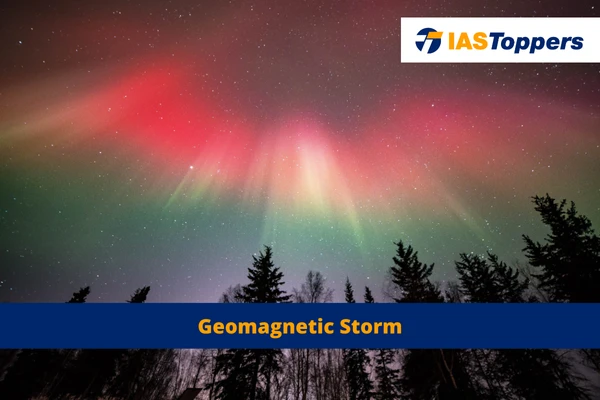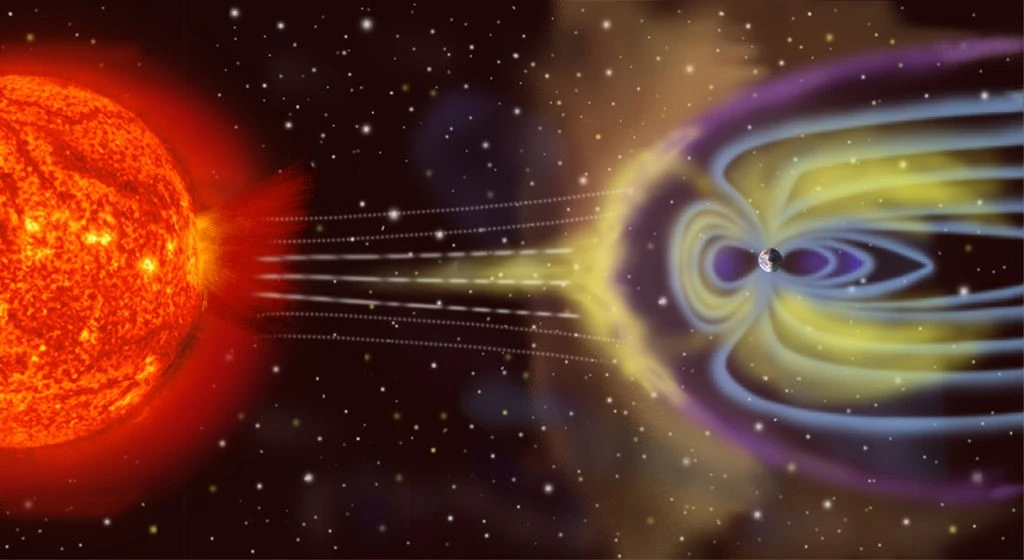Geomagnetic storms are major disturbances of Earth’s magnetosphere caused by solar wind energy exchange. These storms result from variations in the solar wind and have significant effects on Earth’s magnetosphere.
Geomagnetic storms will be helpful for UPSC IAS Exam preparation. GS Paper-3 Science and Technology.
What is Geomagnetic Storm?
- Definition: A geomagnetic storm or magnetic storm is a major disturbance of Earth’s magnetosphere caused by an efficient exchange of energy from the solar wind.
- These storms occur due to variations in the solar wind.
- These storms lead to significant changes in currents, plasmas, and fields in Earth’s magnetosphere.
- Conditions that create geomagnetic storms include sustained periods of high-speed solar wind and a southward-directed solar wind magnetic field at the dayside of the magnetosphere.
Examples of Geomagnetic Storm
- The largest documented geomagnetic storm, known as the Carrington Event, occurred in September 1859.
- It resulted in significant impacts, including the disruption of parts of the newly established US telegraph network.
- It also caused fires and electric shocks to telegraph operators.
- Another notable event took place in 1989 when a geomagnetic storm induced ground currents that caused disruptions in electric power distribution across most of Quebec.
- This storm led to the occurrence of auroras as far south as Texas.
Causes of Geomagnetic Storms
- Solar coronal mass ejections (CMEs) can cause the largest storms.
- CMEs involve plasma and embedded magnetic fields from the sun.
- CMEs usually take several days to reach Earth, but in some cases, they can arrive in as short as 18 hours.
- High-speed solar wind stream (HSS): HSS is another solar wind disturbance that creates conditions favourable for geomagnetic storms.
- HSSs collide with the slower solar wind and create co-rotating interaction regions (CIRs), which can also lead to geomagnetic storms.
Measurement of Geomagnetic Storm
- Geomagnetic storm intensity is measured and reported using various methods, which include:
- K-index
- A-index
- G-scale employed by the U.S. National Oceanic and Atmospheric Administration (NOAA)
- G-scale rates the storm from G1 to G5, where-
- G1 being the weakest, and
- G5 being the strongest.
- The G-scale corresponds to Kp values, with-
- G1 corresponding to a Kp value of 5, and
- G5 corresponds to a Kp value of 9.
- The G-scale classification follows the order G1, G2, G3, G4, G5.
Effects of Geomagnetic Storm
Navigation Systems (GPS) errors
- The most crucial effects of solar activity are seen in navigation systems like GPS.
- Geomagnetic storms cause an increase in the ionosphere between satellites.
- This increase leads to malfunctioning GPS systems and generates position calculation errors.
- These errors can reach up to 100 m, while the average accuracy of a functioning GPS system is ≤ 7.8 m.
- In some cases, the navigation systems may completely lose signal.
Satellite Drag
- Solar activity also causes a significant effect known as satellite drag.
- During periods of higher solar activity, the drag force on satellites increases and alters their orbits.
- This occurs because the increased ion flux from the Sun displaces low-density air layers from LEO (Low Earth Orbit) to higher positions.
- The displaced low-density layers are replaced by higher-density layers that were previously at lower latitudes.
- As a result, the satellite experiences a stronger drag force when it passes through the higher-density layers.
- This increased drag force can lead to the satellite falling to Earth or colliding with space orbiting debris, resulting in a total loss of the satellite.
- Example: The Skylab, which re-entered the atmosphere several years earlier than planned.
Solar cell degradation
- The power-generating capability of satellite solar panels decreases during the Sun’s extreme activity.
- This degradation shortens the panels’ lifetime by several years.
Star Sensor Units malfunction
- During Solar storms, charged particles from the Sun affect integrated circuits (ICs).
- The particles create electrons that charge up the pixels in the Star Sensor Units.
- This charging causes a mix-up in the altitude control of the units.
Effects on Military Systems
- Geomagnetic storms also impact military systems.
- Multiple errors occur in tracking missiles and GPS during these storms.
- These errors make it challenging to intercept hostile missiles effectively.
- Satellite communications may also experience disruptions for up to several hours.
Conclusion
Geomagnetic storms have notable examples such as the Carrington Event in 1859 and the 1989 storm in Quebec. They are caused by solar coronal mass ejections and high-speed solar wind streams, and their intensity is measured using various methods. They have effects on navigation systems, satellite drag, solar cell degradation, star sensor units, and military systems.
Ref: Source-1
| Other Articles in Environment & Disaster Management | |
| World Meteorological Organization | Glacial Lake Outburst Flood |
| Disaster Management in India | Smog |
| Urban Flooding | Central Pollution Control Board (CPCB) |
FAQs (Frequently Asked Questions)
What is Geomagnetism?
The magnetic field of the Earth is known as Geomagnetism. It originated in ancient China and Greece, where the properties of natural magnets (lodestones) were first recognised.
What is Geomagnetic Reversal?
It is a geomagnetic reversal is a change in a planet’s magnetic field. It means changes in the positions of magnetic north and magnetic south are interchanged.


